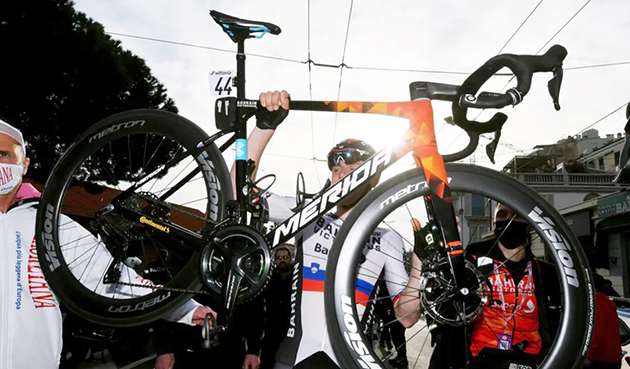

David Stanley
Cycling's Bloodbath Is Real, or
...race organizers and the UCI are the real confederacy of dunces
David Stanley is an experienced cycling writer. His work has appeared in Velo, Velo-news.com, Road, Peloton, and the late, lamented Bicycle Guide (my favorite all-time cycling magazine). Here's his Facebook page. He is also a highly regarded voice artist with many audiobooks to his credit, including McGann Publishing's The Story of the Tour de France and Cycling Heroes.

David L. Stanley
 David L. Stanley's masterful telling of his bout with skin cancer Melanoma: It Started with a Freckle is available in print, Kindle eBook and audiobook versions, just click on the Amazon link on the right.
David L. Stanley's masterful telling of his bout with skin cancer Melanoma: It Started with a Freckle is available in print, Kindle eBook and audiobook versions, just click on the Amazon link on the right.
David L. Stanley writes:
In the Tour de Pologne in August 2020, Dylan Groenewegen took Fabio Jakobsen into the barriers and damn near killed him. In April 2024, a horrendous stage 4 crash clobbered Remco and Jonas and a host of others. The “Carnage at Brugge-De Panne” March 26, 2025—with a couple km to go, there were around 40 riders left in the lead group. With 200 meters to go, there were perhaps 8 men standing.

The carnage at the 2020 Tour of Poland stage one finish line. Photo: Kraska W Katowicach-PAP
Crashes are bad. Crashes deprive spectators of the hard-core spectacle of the lead-out trains screaming along at 40 mph as they launch their sprinters at 45 mph towards the finish. High speed crashes in the peloton as they are on the move take out stars and watercarriers alike. Crashes cause riders horrible pain. Crash-caused injuries shorten careers. Traumatic brain injuries cause serious long and short term disorders. There is nothing romantic and “hardman-ish” about the bike crash at speed. If those in charge cannot solve the problem of riders who slam into pavement and barricades and road furniture at high speeds, it truly is the moment when we realize that riders are nothing more than disposable.
From my couch, it certainly looks like riders are crashing far more often than ever before. Now, I lack data, and Sherlock Holmes always said that it was a capital mistake to theorize before one had all the data in one’s hand, but I’m going to dive on in, just the same. Despite what we read as posited by the UCI and its shareholders, in the main, crashes are not caused by high speeds. Crashes are far more complex than riders who have stepped up race speeds from 50 kph to 55+ kph.
About that data. Someone must keep track—the UCI, the rider union, the SafeR organization; somebody somewhere has to be keeping track of how often and in what circumstances riders hit the deck, at what point in the race, at what estimated speeds, in what weather, with what outcomes. Without data, you can’t solve the problem. You’re Ted Lasso throwing darts without the barbecue sauce.
If nobody has this data, that tells us all we need to know about how lightly the UCI regards this problem.
Gear limits are not the answer. At best, they are a band-aid that will not solve the underlying issues. What gear limits do is punish sprinters who can muscle their 56x11 around at 100 rpm, and not punish the guys who can spin their 53x12 at 115 rpm. Simply slowing the riders down won’t change a thing except the crashes will take place at slower speeds.
The Big Issues.
Modern bike design.
1) Narrow bars. While the extremely narrow bars we saw several years ago have been banned, the current minimum width is set at a still-narrow 350 mm. That’s about the diameter of an ordinary large pizza. Bars are still far more narrow than the 400-420 width bars that predominated until about 10 years ago. The slightest judder to a narrow, modern bar sends shock waves down to the front wheel and causes a much greater swing in the front wheel from side to side. In short, narrow bars are really twitchy.
2) Overweighted front ends. Again, until 10-15 years ago, more rider weight was positioned over the rear wheel. This contributed to a more stable ride. In pursuit of the modern, super aero position, riders are canted far more forwards than ever before. The ‘high saddle, slammed stem’ fit creates an amplification of the narrow bar issues. The bicycles of the early part of this century were far better balanced machines. In short, you put more weight on the front wheel, it gets really twitchy. Think back to the 2022 Milan-San Remo. Matej Mohoric attacks on the Poggio descent with 5 km to go. He is unfollowable. His secret weapon? A dropper seatpost that radically altered the weight distribution of his Merida bicycle.

Matej Mohoric holding his winning 2022 Milano-Sanremo bike with its dropper seat post. Getty/Dario Berlingheri photo
3) Straight, vertical arms. Again, the modern position sacrifices stability for aerodynamics. A rider who sits further back on the saddle, and has a slight bend in their arms, has a built-in set of shock absorbers not seen in modern frame design. In a modern bike, riders’ arms are nearly vertical and the deep reach encourages a straight-armed, stiff position. That makes this position, yes, twitchy.
Conclusion.
I am not a “Get Off My Lawn” guy. While I love the old stuff; steel frames, retro-rides, Eroica’s, and the smell of Tubasti as I glue on a Vittoria CX sew-up, modern bikes are a vast improvement in every way. Except the stuff I mentioned above.
Lack of basic skills and training.
1) Whether due to the pandemic, a huge upswing in vehicle/cyclist collisions, or some combination thereof, we all ride indoors far more than ever. Call it the “Zwift effect.” There are plenty of new racers out there with the ability to generate massive watts in the sprints, and on the climbs generate unthinkable W/kg numbers, but that doesn’t mean that they can handle their bikes properly in a full-field sprint lead-out after racing full gas for 200 km or in the gutter with a 40 kph crosswind. If you doubt this, watch GCN’s Zwift Academy videos and you will see hugely talented humans who can push 6 watts/kg up the hill, but cannot sit on a wheel properly who also let big gaps open whenever their wheel ahead picks up speed. There is a solution…
2) Velodrome training. Every velodrome everywhere mandates training programs for their new riders before they let them mix it up on Friday nights. Too many cyclists with massive engines have risen to the top on the basis of their fitness without a simultaneous rise in bike handling skills. I posit that if you take these new pros to the velodromes for a week long camp, put them through the same skills training that every day riders undergo, you will see crash rates fall immediately.
3) Riders with extraordinary skills. Tom Pidcock and MvDP are a master bike handlers. Why? They have spent thousands of hours training and racing in MTB/offroad and CX events. Every sprint, every bit of time on the flats when riders are chasing full-gas, you get a field that’s a mixture of top handling pros and relative newbies. Get out the stopwatch because you can count the minutes until something bad happens.

Tom Pidock winning the 2023 Namur cyclocross race.
You might not recognize the name Ethan Jeff-Hall. He’s 16, and the current FIA GoKart driver world champion. He’s gonna be something special in F1. But if you were to plop him into the F1 car of AMG-Mercedes colleague Andrea Kimi Antonelli at the Bahrain GP in mid-April, in the midst of the 19 fastest cars and drivers in the world, you have a recipe for disaster.
Conclusion.
We can no longer assume that top pros have worked their way up from the bottom of the race world and learned their trade in the gutters of Belgian road-racing and the cut-throat slice and dice of the kermesse. You want them to succeed, teach them the skills they need to maximize what they already possess: their engines, heart, dedication, and discipline.
Course design.
1) Roads have changed immensely in the last 50 years. There are roundabouts everywhere. Divided roadways that aren’t carriageways are common. Road dots and cat-eyes and speed bumps have multiplied like bacteria on agar plates in the lab. We can’t undo them for a bike race. [WATCH HERE for an example of all things race organizers do wrong. TdF Stage 12. 2024] But we can improve rider safety. When the road divides, merely wrapping the three foot tall divider in a Hi-Vis yellow bumper is not enough. Those bumpers can’t be seen until you’re on top of them.
Mount a 3-4 meter flexible plastic pole (think a gate from alpine ski racing) with a pennant at the top, on the top of the road divider so that riders closing in on the division have a fair shot at seeing the divider. Similarly, when speed bumps and/or a section of cat-eyes approach, mandate those same warning flags at either side of the roadway to announce the approaching hazards. It’s not a fail-safe, and I’m sure we’ll have a better alternative in the future, but for today, let’s bust out the early-warning system, just as many races now do with huge flashing yellow signage to indicate abrupt turns during descents.
2) Corners and bends in the closing kms of races/stages. In alpine ski racing, there are technical delegates (TD) whose sole job is to make sure that all the safety netting and similar skier safety features are in the proper places, that run-outs are available, that no part of the course sweeps too close to a lift tower or tree—in short, they are they to maintain high levels of safety for racers who are racing at 100 kph.
Where is that same attitude towards racer safety in our sport? Too many times, we see bends and turns and narrowing of the road in the last few km of a stage that guarantee that riders will be in danger. Just because a town pays for a stage or race finish, and they want it to loop through certain sections of the community to end up in favored neighborhood does not mean the UCI and the race organizers have to comply. These contracts are drawn up long before the race day. Months ahead of race day, you send out the TD, they meet with the local officials, and together, they devise a run-in and final sprint that showcases the locale and ensures the maximum safety for the rider. And if these sorts of meetings are currently in place, someone is not properly doing their job as TD.
3) Rapid and un-warned narrowing of roads. It’s not that fields have 180 riders that causes crashes. The problem arises when a field of 180 is racing 10 abreast and suddenly, the road pinches down to 6 abreast. Un-warned, there is nowhere for all those riders to go. Again, this would fall under the purview of a TD. Those big flashing yellow signs we see on descents? They’d work great in these situations. But they can’t be only at the entry to the pinch points. The heads-up needs to start 1-2 km before the pinch points so the riders have room to maneuver themselves to safety within the peloton. Put the flashing signage 1.5 km before the pinch points with the 4 meter tall warning pennants every 350 m from there until the road narrows. Pricey? Yes. Worthwhile? Absolutely.
Strict Enforcement.
1) I like the red card/yellow card. This sport is intensely competitive. Bike racers are crazy ruthless. These men and women are well-paid for taking risks and winning races. Riders in the closing meters will always take risks. But they need to take sporting risks that do not endanger their competitors. There is a line. When you cross that line and endanger someone, you also risk harming their team, their family, and that rider’s ability to earn an income. You take someone out? You’re DQ’ed on the first offense, suspended on the second.
2) Sprinter lanes. I’ve brought this up before and was laughed at. But I don’t care; here we go again. In the closing 350 meters of a stage or race, paint stripes down the road, 2 meters apart. A) this will give sprinters and their leadouts a visible reminder of what a straight line looks like. Trust me, you are on the absolute limit, head down and full-gas at the end of a long, fast stage, straight is not necessarily part of your thinking process. B) Once launched, a sprinter who leaves his lane, except in the case of crash avoidance or similar, is relegated to last on the first offense, DQ’ed from the race on second offense, and suspended on the 3rd.
Paint stripes are slippery, you say? Agreed, especially in the rain. You should know that skid-resistant road paint is available; runs about $100 per gallon. Cheap insurance against the end of a professional athlete’s career, eh?
We can never eliminate crashes. In nearly every racing sport, crashes happen. It is part of sport that we put ourselves at risk. The key is that we put ourselves at reasonable and acknowledged risk.
It’s long past time for race organizers, the UCI, and the rider union to come together to determine what are the acceptable risks and the best ways to minimize the unacceptable risks.
Riders are not disposable assets.
David Stanley, like nearly all of us, has spent his life working and playing outdoors. He got a case of Melanoma as a result. Here's his telling of his beating that disease. And when you go out, please put on sunscreen.







